Six Traits of Evolutionary Design in Non-Spill Couplings
The following six traits describe the evolution of the non-spill coupling tailored for low-pressure environments.
Evolutionary trait #1: Maintenance of flush-faced valves
The design of non-spill valve technology is not new; what is new is the migration of the flush-faced valve to connectors for flexible tubing used in low-pressure applications.
Connecting and disconnecting in low-pressure environments was historically accomplished with a poppet-style valve. This valve style traps liquid in the valve cavity on the external side of the valve seal. Though the valve has shut off the flow, this remaining volume of fluid can “spill” from the coupling.
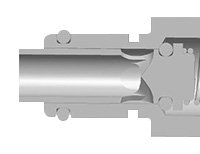
In contrast, the flush-face valve, due to its design, allows no more than a coating of liquid on the valve surfaces, thereby nearly eliminating spillage and ensuring repeated dripless connections and disconnections. Inclusion, or the air put into the fluid system during every connection, is also drastically reduced with flush-face valve design. The benefits of near-zero spillage and inclusion have become important in many applications, from medical devices and equipment to chemical handling.
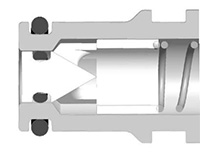
Evolutionary trait #2: Switch from metal to engineered polymers
Metal housings and internal valves were originally chosen for non-spill couplings due to the pressure demands of hydraulic applications. Low-pressure environments do not necessarily require the performance attributes of metal housings and internal valves. Design engineers looking only at metal high-pressure coupling alternatives may be limited in the available selection of weight, package size, flow performance and, in particular, cost. Stainless steel offers the widest chemical compatibility but is also the most expensive metal choice.
As an alternative, engineered polymers have gained a substantial foothold in applications where metal had been the industry standard. Reduced weight, high strength and rigidity, and the ability to achieve complex part geometries are all benefits of engineered polymers. Choosing polymer couplers can provide savings of 50 to 75% compared to metal disconnect products. Some non-spill couplings also incorporate a soft-touch over-mold for superior ergonomics and color coding. Others feature a glass-filled polypropylene body that offers chemical resistance and increased durability.
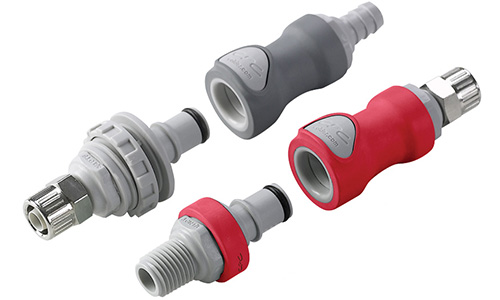
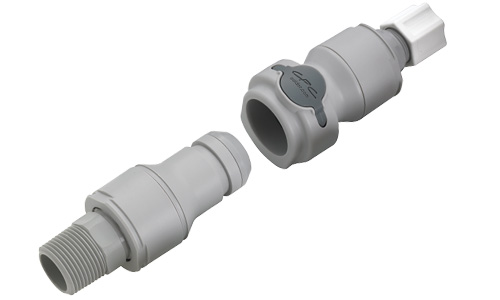
Evolutionary trait #3: Low-pressure environments, minimal pressure drop
In low-pressure fluid handling applications, systems typically operate in the pressure range of vacuum to 120 psi (83 bar). The use of non-spill quick disconnects designed for applications operating in the 10,000 psi range is overkill.
A quick disconnect designed specifically for low-pressure fluid handling applications can deliver all the desirable features of low spillage, low air inclusion and minimal pressure drop. Low-pressure quick disconnects provide higher flow and lower pressure drop compared to their metal counterparts by leveraging the design flexibility gained through the use of plastics and advanced manufacturing techniques, as well as their efficient, high-flow valve design.
Evolutionary trait #4: Compact design
Many low-pressure applications requiring a non-spill coupling also demand a compact design, due to both smaller diameter tubing sizes and the interior or hard-to-access locations where many non-spill couplings are applied. For instance, non-spill couplers used in server racks for liquid cooling or inside in vitro diagnostic equipment need to be as compact as possible to minimize product real estate used and to allow room for technicians to connect and disconnect the couplers.
Today’s increasingly compact couplings are achieved partially through the internal design of the coupling. Some manufacturers provide non-spill couplings that can connect tubing with an inside diameter as small as 1/16” or less.
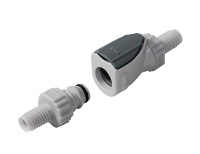
Evolutionary trait #5: Ease of use
An enduring characteristic of high-pressure couplings is the physical difficulty users can have in connecting and disconnecting the couplers. When connecting the couplers, the process can require significant amounts of force. This user inconvenience is addressed in the design of some low-pressure quick disconnects with the introduction of an ergonomic thumb latch that makes the process of disconnecting much easier.
Another user benefit provided by some new non-spill connectors is an audible “click” that sounds when a secure connection is made.
Evolutionary trait #6: Chemical compatibility
For certain low-pressure fluid-handling applications, the chemical compatibility of the fluid and the connector or its parts needs to be considered. Unlike hydraulic applications — where fluid and metal do not react with each other — low-pressure fluid-handling applications can involve media that reacts with metal.
To address this potential concern, connector designers use polypropylene (which offers chemical resistance to many fluids) or other engineered thermoplastics. Some applications also require a metal-free flow path. One method to achieve this is to isolate the springs from the flow path through the use of an O-ring. This ensures a degree of separation between the fluid and any metal. The O-ring seals separate fluid flow from the valve actuation springs, thereby ensuring high-purity flow paths well suited to applications such as semiconductor manufacturing. In some non-spill couplings, coated springs give a second degree of separation between fluid and metal.